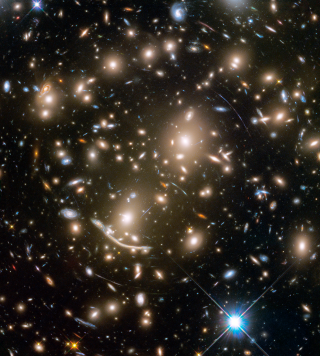Bibcode
Boschin, W.; Girardi, M.; Barrena, R.; Nonino, M.
Referencia bibliográfica
Astronomy and Astrophysics, Volume 540, id.A43
Fecha de publicación:
4
2012
Revista
Número de citas
27
Número de citas referidas
27
Descripción
Context. The mechanisms producing the diffuse radio emission in galaxy
clusters, and in particular their connection with cluster mergers, are
still debated. Aims: We seek to explore the internal dynamics of
the cluster Abell 1758N, which has been shown to host a radio halo and
two relics, and is known to be a merging bimodal cluster.
Methods: Our analysis is mainly based on new redshift data for 137
galaxies acquired at the Telescopio Nazionale Galileo, only four of
which have redshifts previously listed in the literature. We also used
photometric data from the Sloan Digital Sky Survey and from the
Canada-France-Hawaii Telescope archive. We combined galaxy velocities
and positions to select 92 cluster galaxies and analyzed the internal
cluster dynamics. Results: We estimate a cluster redshift of
⟨z⟩ = 0.2782 and quite a high line-of-sight (LOS) velocity
dispersion σV ~ 1300 km s-1. Our 2D analysis
confirms the presence of a bimodal structure along the NW-SE direction.
We add several pieces of information to the previous merging scenario:
the two subclusters (here A1758N(NW) and A1758N(SE)) cannot be separated
in the velocity analyses and we deduce a small LOS velocity difference
(ΔVrf,LOS ≲ 300 km s-1 in the cluster
rest-frame). The velocity information successfully shows that A1758N is
surrounded by two small groups and active galaxies infalling onto, or
escaping from, the cluster. Removing the two groups, we estimate
σV,NW ~ 1000 km s-1 and
σV,SE ~ 800 km s-1 for A1758N(NW) and
A1758N(SE), respectively. We find that Abell 1758N is a very massive
cluster with a range of M = 2-3 × 1015
h70-1 M&sun;, depending on the adopted
model. Conclusions: As expected for clusters that host powerful,
extended, diffuse radio emissions, Abell 1758N is a major cluster merger
just forming a massive system.
Proyectos relacionados

Evolución de Galaxias en Cúmulos
Las estructuras en el Universo, a todas las escalas de masa, se han formado de una forma jerárquica y principalmente producidas por fusiones de galaxias. Sin embargo, esta formación jerárquica de las galaxias está modulada por el entorno en el cual se crean y evolucionan. Mientras que las galaxias de campo presentan una evolución pasiva, los
Jairo
Méndez Abreu

Cosmología con Trazadores de la Estructura a Gran Escala del Universo
El Fondo Cósmico de Microondas (FCM) contiene la información estadística de las semillas primigenias que han dado lugar a la formación de todas las estructuras en el Universo. Su contrapartida natural en el Universo local es la distribución de las galaxias que surgen como resultado del crecimiento gravitatorio de aquellas fluctuaciones de densidad
FRANCISCO SHU
KITAURA JOYANES